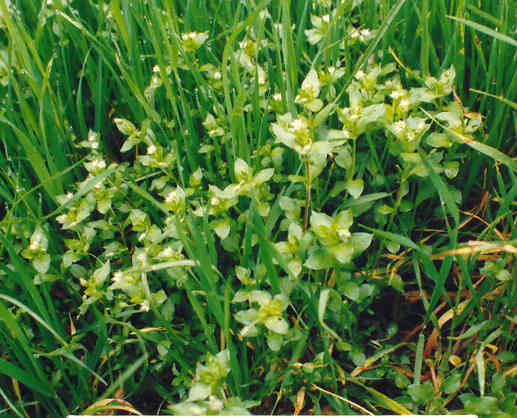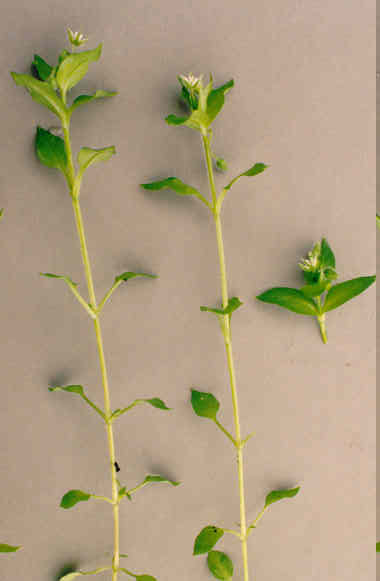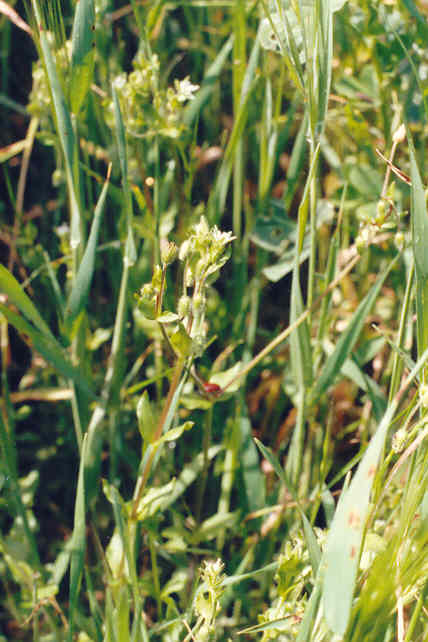
Stellaria media (L.) Villars
Caryophyllaceae (Pink Family)
Eurasia
Common Chickweed
Starwort
 |
Stellaria media (L.) VillarsCaryophyllaceae (Pink Family)Eurasia
Common ChickweedStarwort
|
March Photo
Plant Characteristics:
Annual with weak procumbent stems 1-4 dm. long and with a line of hair
running down each internode; lvs. ovate, acute, 1-3 cm. long, short-petioled or
the upper sessile; cymes leafy; sepals five, pubescent, ovate, 4-5 mm. long;
petals five, 2-parted, or wanting,
white, shorter than the sepals; caps ovoid, slightly exceeding calyx; seeds
minute, roughened.
Habitat:
Common weed in shaded places, such as in orchards, etc., through most of
cismontane Calif. Feb.-Sept.
Name:
Latin, stella, a star, because
of the star-shaped fls. Latin, medius,
middle. (Jaeger 151). This species is midway in size between two others that are
not native here. (Dale 94).
General:
Rare in the study area having been found only once and this in the 23rd
St. area about 100 feet from the street end on the southerly side. Found in 1993, a wet year
and in subsequent wet years the plant has been found in this same location
(my comments). It is one of
the earliest weeds in California, often coming up in onion fields, asparagus
beds, with peas, and other crops during rainy springs, and giving trouble before
the soil is dry enough to cultivate. (Robbins
et al. 185).
Chickweed is widely used raw or as a potherb in Europe, where it is
native. Indians used the tiny seeds
for bread or to thicken soup. It is
one of the few herbs possessing a good copper content. Chickweed was once sold in the streets to be cooked, used as
a poultice for abscesses and carbuncles, or infused into a tea to comfort
troubled stomachs or to slim down fat people.
It can be used in sandwiches or salads or cooked like asparagus tips.
It shrinks when cooked so a good supply is needed. Its
bland flavor goes well with stronger greens such as Chicory or mustard.
The tender leaves are relished by game birds and songbirds.
(Clarke 188). The fresh plant (mashed for a
poultice), the fresh plant juice, the tincture, or the salve are all useful
topically for swellings. Deeper
pain contusions are too far into the body for Chickweed to help.
The dry plant is a useful diuretic for premenstrual water retention, or
retention in athletes using steroids. (Moore,
Medicinal Plants of the Desert and Canyon
West 32).
For constipation when the bowels are completely obstructed, take three
heaping tablespoonfuls of the fresh herb, boil in one quart of water down to one
pint. Take a cupful warm every
three hours or more often until the desired results are obtained.
Anyone who is covered with any kind of sores should take a chickweed herb
bath, and then apply the chickweed salve. (Kloss
232). This
herb is used for liver ailments (internally and externally), bronchitis,
pleurisy, coughs, hoarseness, rheumatism, inflammation or weakness of the bowels
and stomach, lungs, bronchial tubes, scurvy, to ease hemorrhoids; to release the
small vessels that transmit blood from the liver into the hepatic veins, making
them more pliable. This so-called
common plant could be
Stellaria media,
page two
included among the all-purpose herbals.
(Hutchens 66).
A genus of about 100 species of wide distribution.
(Abrams, Vol. II 137).
Text Ref:
Abrams, Vol. II 138; Munz, Flora
So. Calif. 348; Roberts 18.
Photo Ref:
Dec-April 92-93 # 13,19; Mar 95 # 5,7.
Identity: by R. De Ruff,
confirmed by John Johnson.
First Found: March 1993.
Computer Ref: Plant Data 448.
Have plant specimen.
Last edit 3/1/05.
 |
 |
March Photo March Photo